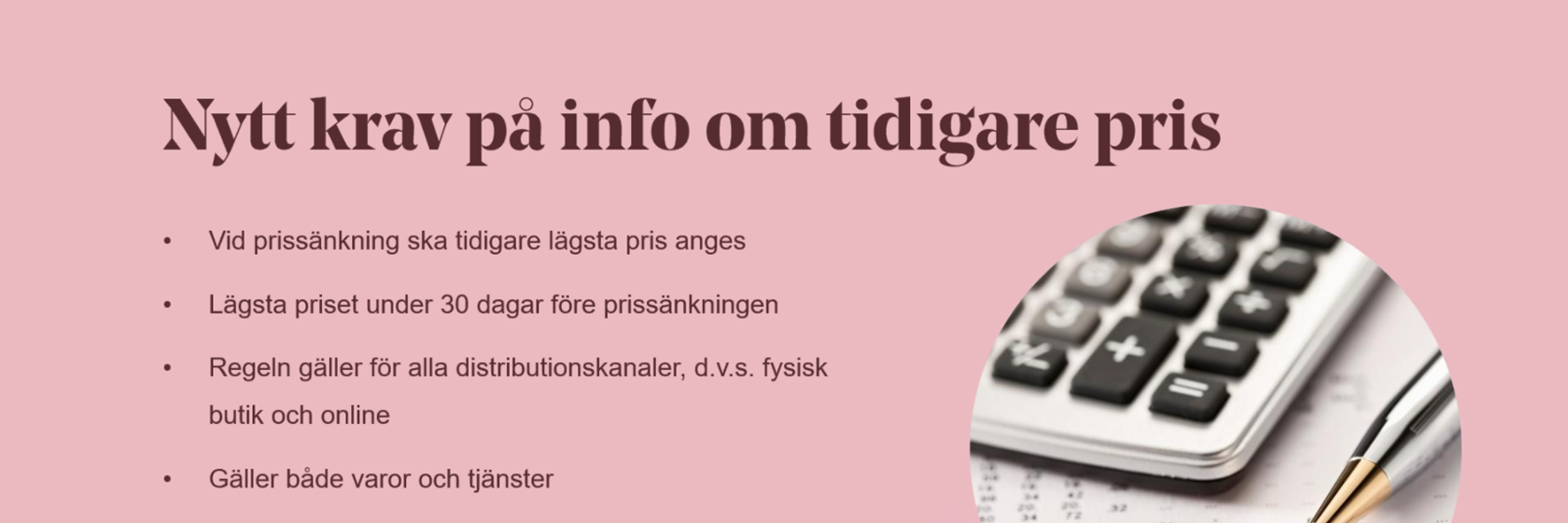
The modernized consumer protection is a package of rules with a few different points:
- Information requirements for consumer reviews.
- Information requirements for online marketplaces.
- Changed information requirements for distance contracts.
- New penalty fees.
- Information requirements for price reductions.
Today's rules on price information as well as campaigns and sales
Approximate price and recommended price must already have actually been recommended in previous sales stages and have been applied to a certain extent in the market. The prizes must not have been made up and never been used.
Already today, you must not raise the price of an item just before a sale and then have a promotion, sale or price promotions must not be misleading.
Sales and promotions may only be used if the products are part of the regular range and are valid for a limited time. The prices must also be significantly lower than the company's regular prices.
An exception is customer evenings and the like.
New requirement for information on previous price
The new modernized consumer protection introduced on 1 September 2022 is based on EU directives that are implemented in national legislation - introduced in the Price Information Act and is intended to protect consumers against misleading price reductions.
For products that have been on the market for less than 30 days, you must enter the lowest price since the products went on sale.
Price reduction announcement
There are different ways to announce a price reduction:
- New red prices – that an impression is made that the price is lower.
- Percentages or amounts linked to the price, eg 20% discount or SEK 50 discount.
- Crossed out price has been replaced with a new price.
- Concepts such as sale price, special offer, Black Friday offer.
It does not count as announcing a price reduction in the case of regular price adjustments or dynamic pricing. General claims such as Low prices, Best price, Price guarantee, Always good offers are also not counted as sales. Price comparisons are not covered and not 2 for 1 offers or similar package offers.
There are also some exceptions:
- Goods that can deteriorate or have a short expiry date such as fresh food and plants.
- Gradual price reductions without interruption. Eg seasonal sales with 30%, 50%, 70%. Then you don't have to compare with 50%, but can compare with the lowest price before the price reduction, given that there was no interruption in the sale period and the price has gradually continued to be lowered.
- Discounts for longer consecutive periods within the framework of a customer club and points system.
- Exceptions for personal price reductions that are not in practice aimed at all consumers, eg linked to the consumer's previous purchases, individual occasions such as birthdays.
Example of previous lowest price
If the price varies over time – no sale or indication of price reduction or promotion. Then there is no requirement to enter any type of previous price, regular price or recommended price.
Main rule for sale price reductions – the company lowers the price of selected goods. In the last 30 days before the price reduction, the price has varied slightly and recently demand increased, whereupon the price was raised by a few percent before the price reduction. You may then not compare with the higher price, but the reference price is the lowest price during the last 30 days before the price reduction.
Successive reduction – if it is the same sale campaign, without interruption with a higher price. Then you can enter the lowest price applied during the last 30 days before the first reduction, provided that it is a continuous sale without a price increase. If, for example, there is a 1-day interruption in the campaign, you must compare it with the previous sale price if you make a new price reduction after the interruption in the campaign.
Enter previous price and percentage sale
Previous price must be the 30-day price – not regular or recommended approximate price or similar. There is no requirement to have regular or recommended price somewhere. If you choose to still have it as a third price, you must be careful how it is stated so that it does not become misleading as to what is the lowest price during the last 30-day period.
When a percentage sale is to be stated, it is on the relevant price that the percentage should be calculated, the lowest price used in the last 30 days, not the regular price or the recommended price.
Do a legal review of your site and customer journey and set routines, guidelines and division of responsibilities. Also think about how you will work with sales to consumers. Please read more and follow Delphis Tech Blog.
